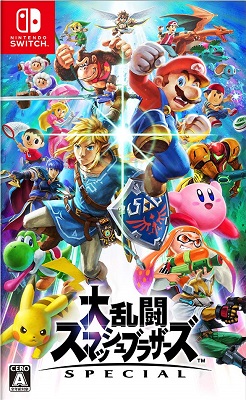Super Smash Bros. Ultimate (2018)
[大乱闘スマッシュブラザーズ SPECIAL]

Publisher: Nintendo
Developer: Bandai Namco Studios, Sora Ltd.
Director: Masahiro Sakurai
Platform: Nintendo Switch
Overview:
Everyone is back for the latest entry in Super Smash Bros. franchise along with new challengers.
Gameplay:
The core mechanics remain basically the same, so veterans of the series can pick it right up. Of course, the basic gameplay is designed so that anyone can pick it right up, so there's that too. There are numerous tweaks that have been done and I'll admit that I'm far to casual of a player to go into it in any real depth. At its heart, it's simple fun as it's always been and that's enough for me.
The game is divided into five main areas. Smash is standard matches, where you can make various adjustments to the rules, set up tournaments, group battles, etc. Next is the online mulitplayer, which I haven't touched (because I don't like playing online) and can't comment on. We have the Spirits section, which includes the World of Light adventure mode, somewhat akin to the Subspace Emissary from Brawl or the Event battles from 4, where you have a map and assorted missions to clear. Then there's Games & More, with various other modes like Survival Smash, training, Mii Fighter creation, stage creation, and amiibo support. Lastly is the Vault, where you have the sound test, play stats, the shop, etc.
I've spent most of my time in the Spirits section of the game. Besides running the World of Light, I've been working on accumulating Spirits via the Spirit Board. The Spirit Board randomly generates ten Spirits for a limited time. These are the same challenges you face in the World of Light. The Spirits themselves are a cross between the stickers from Smash 4 and the trophies that have long been a series staple. They are divided between attackers and supporters. The attackers come in red, blue and green, forming a rock-paper-scissors triad, plus the neutral colorless. The attackers have slots for supporter Spirits, which provide various status effects and so on. You can level your attackers by using them in battle, feeding them materials, or sending them to a gym. Certain attackers can be evolved into higher forms. There are also certain Spirits that can only be acquired by using other Spirits to summon them. (If you're worried about losing Spirits to this process, don't. The ones you sacrificed will show back up on the Spirit Board.) It should be noted that Spirits can only be used in the Spirits section, so no Level 99 Black Knight giving you fire immunity for online play.
There are a staggering number of stages, since not only are all the old stages back but also some new ones as well. The Final Destination crowd will appreciate that every stage has a Final Destination version that cuts out environmental hazards and such.
While there's certainly no lack of content, it does feel a little disappointing that some classic modes such as the Homerun Contest are absent. I'm sure a lot of effort went into refining the multiplayer element, particularly online play, and that's stuff I don't even touch.
Story/Characters:
The opening movie for World of Light provides almost all the story we get. It's not like Subspace Emissary which is littered with cutscenes. If you want a narrative, you'll have to make one up.
It was big news when they revealed all the characters from previous entries would be returning. Of course they didn't leave us without new characters either. The Echo Fighter (Dash Fighter in Japanese) concept doesn't really change anything, but it is a nice way to reconceptualize the moveset clones.
Graphics:
As far as my eyes are concerned, this is an absolutely gorgeous game. Smash has never looked better. Normally I play my Switch in portable mode, but the first time I booted the game up, it was on my sister's 65-inch TV. I certainly didn't have any complaints. The character models look good, the environments too, and the effects are suitably flashy.
Music/Sound:
Just as they brought all the old characters and stages back, the same is true of the music. I've seen differing accounts of the total number of tracks, so I'll just say there are nearly 900 in total.
The feature track for this entry is "Inochi to Tomoshibi" (known in English as "Lifelight"). While it doesn't bowl you over like "Audi Famam Illius" did when it was revealed (but that was a totally unexpected operatic Latin ballad composed by none other than Nobuo Uematsu), it's a nice song and a good fit for the game.
Other:
Unlike the piecemeal DLC offerings for Smash 4, everything is bundled into a single package this time around. I haven't committed to buying the Fighter Pass yet. Probably once all the DLC characters have been announced, I'll probably get it, but until then, I can't comment on the value for your money. It seems fairly reasonable, though.
Conclusion:
I thought Smash 4 would be my final hurrah with the series, but I couldn't very well resist after seeing what all this entry had to offer. I'm getting to the point where I can't quite enjoy the game to the fullest, but I've still had a lot of fun and am glad I got it. If you're a Smash fan, you've surely got it by now, but if you're a Switch owner who's on the fence, get it.
Rating:
Own It
